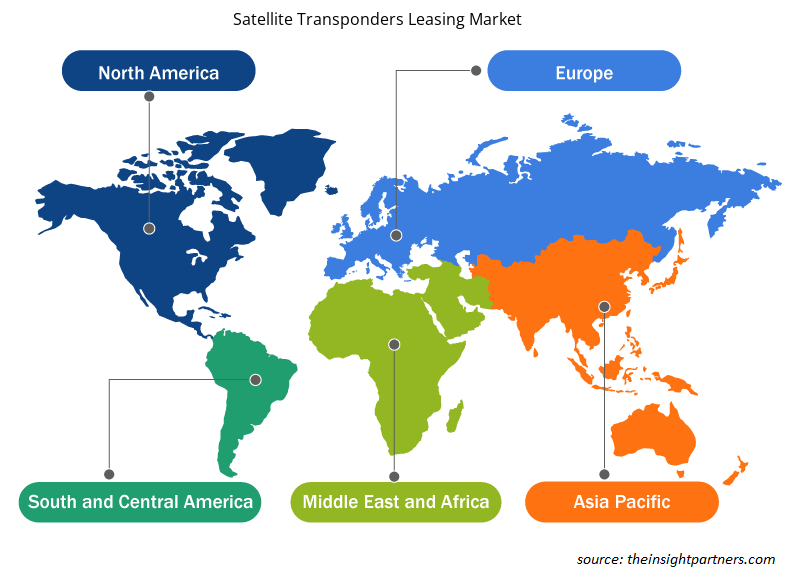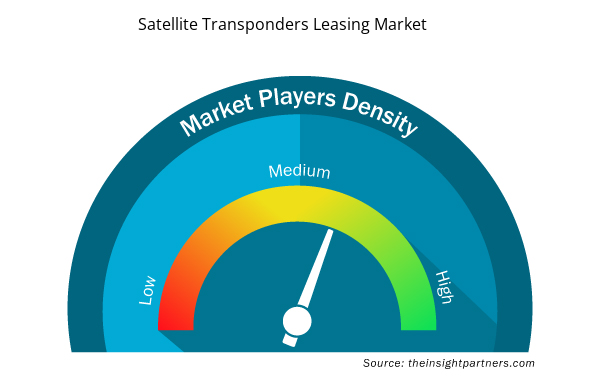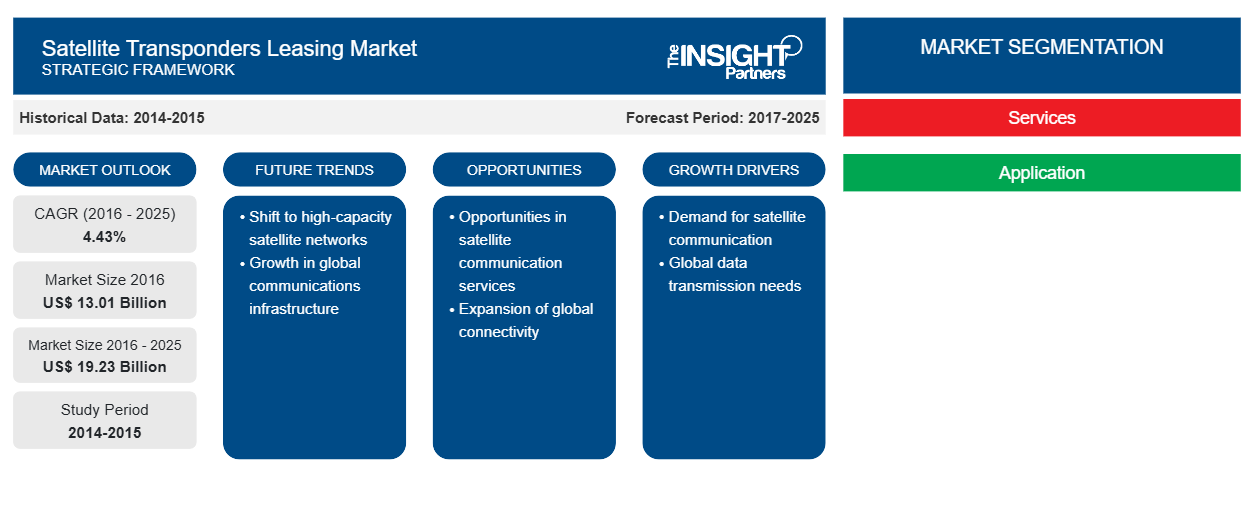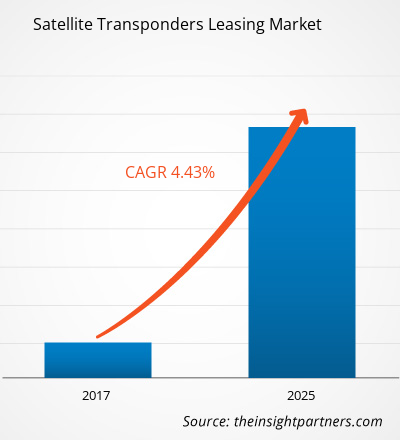Se espera que el mercado de arrendamiento de transpondedores satelitales crezca de US$ 13.010 millones en 2016 a US$ 19.230 millones en 2025 a una CAGR del 4,43% entre 2016 y 2025.Bn in 2016 to US$ 19.23 Bn by 2025 at a CAGR of 4.43% between 2016 and 2025.
Se prevé que el mercado de alquiler de transpondedores satelitales crezca tanto en términos de cobertura como de capacidad, ya que las frecuencias de banda Ka y banda Ku son las que impulsan el crecimiento del mercado; además, se espera que el creciente número de actualizaciones de suscriptores y nuevos suscriptores también impulsen el mercado global de transpondedores satelitales. Además, debido a los avances tecnológicos actuales en las comunicaciones por satélite, se espera que surjan varias aplicaciones nuevas de los transpondedores satelitales. Se considera que estos satélites son lo suficientemente potentes como para competir con su rival, la banda ancha de línea de abonado digital (DSL), en términos de rendimiento. Se espera que todos estos factores impulsen el mercado global de alquiler de transpondedores satelitales durante el período de pronóstico.
Perspectivas del mercado
La expansión de las aplicaciones en banda Ku generará nuevas oportunidades para el mercado de alquiler de transpondedores de satélites de comunicaciones
La transmisión en vivo y la distribución de video son algunas de las principales aplicaciones de los satélites de banda Ku, también se utilizan para varios servicios de datos, incluidos los servicios VSAT, la conectividad de banda ancha, el back haul móvil, los servicios aeronáuticos y marítimos. En este mundo altamente conectado, todas estas aplicaciones se consideran críticas para el funcionamiento de una empresa/firma. De hecho, la banda Ku es el espectro principal utilizado por las redes de movilidad para brindar conectividad de banda ancha en el área donde las redes terrestres no pueden llegar, es decir, sobre el océano y en la troposfera. La banda Ku captura aproximadamente el 40% del mercado en términos de ancho de banda. Se anticipa que la demanda de transpondedores de banda Ku aumentará debido a la creciente moda de los televisores satelitales, especialmente en las economías en desarrollo, que se ve respaldada además por la HD (alta definición) y la demanda de otras aplicaciones de ancho de banda similares. Se espera que la evolución de los canales 3D que consumen un mayor ancho de banda y requieren un 50% más de capacidad ofrezca un nuevo impulso al mercado de transpondedores satelitales de banda Ku. Le siguen los transpondedores de banda C, que actualmente tienen la mayor participación de mercado, pero se espera que experimenten una caída constante durante el período de pronóstico, perdiendo protagonismo frente a la banda Ku y otros anchos de banda similares. Por lo tanto, se espera que esta expansión en las aplicaciones de banda Ku genere nuevas oportunidades para el mercado de alquiler de transpondedores satelitales .
El arrendamiento de transpondedores como servicio dominará el segmento de servicios globales del mercado de arrendamiento de transpondedores satelitales
En los últimos uno o dos años, el mercado mundial de transpondedores satelitales ha experimentado un aumento de aproximadamente el 4,3-4,5% en la demanda de transpondedores alquilados. Se prevé que esta tendencia aumente aún más debido al aumento de los costes de los transpondedores en todo el mundo. En cuanto al mercado de alquiler de transpondedores satelitales, se observa que Europa es la región más costosa, seguida de Australia y Nueva Zelanda. Mientras que el sur de Asia ofrece las tasas de alquiler más bajas, por lo que se considera que Asia Pacífico es la región más prometedora para el mercado de alquiler de transpondedores satelitales en los próximos años. Recientemente, una empresa de satélites coreana, KT SAT, firmó un acuerdo de alquiler de transpondedores con un operador de televisión por satélite de Mongolia; el proveedor de servicios KT SAT ha contratado el alquiler de cuatro transpondedores, lo que cumpliría el propósito de ofrecer servicios DTH a las empresas de Mongolia que se están iniciando el año próximo. Considerando que se prevé que la empresa DDISH TV se beneficie de los servicios de KT SAT en 2017, el arrendamiento de transpondedores de satélites de comunicación depende en gran medida de la adopción de la transmisión de video HD y de una amplia gama de aplicaciones de alto rango dinámico (HDR). Sin embargo, se espera que los servicios de arrendamiento lideren el mercado de arrendamiento de transpondedores de satélite con una participación de mercado relativamente alta, que está sujeta a fluctuaciones según la revisión del costo de compra de los transpondedores de satélite y el costo total de lanzamiento de un satélite y su mantenimiento.
Personalice este informe según sus necesidades
Obtendrá personalización en cualquier informe, sin cargo, incluidas partes de este informe o análisis a nivel de país, paquete de datos de Excel, así como también grandes ofertas y descuentos para empresas emergentes y universidades.
- Obtenga las principales tendencias clave del mercado de este informe.Esta muestra GRATUITA incluirá análisis de datos, desde tendencias del mercado hasta estimaciones y pronósticos.
La iniciativa de mercado se consideró la estrategia más adoptada en el mercado mundial de alquiler de transpondedores satelitales. A continuación se enumeran algunas de las estrategias recientes de algunos de los actores del panorama del mercado de alquiler de transpondedores satelitales:
2016: GlobalSat otorga licencia para servicios de banda L y Ka de Inmarsat en todo México
2016: MVS USA actualiza su red de comunicaciones por satélite con la mira puesta en la ciberseguridad
2016: O3b y Ozonio llevan banda ancha a otra ciudad amazónica de Brasil
2016: Las escuelas africanas se beneficiarán del nuevo acuerdo entre Gazprom y Gilat
2016: Indonesia crea acceso de banda ancha en áreas desatendidas con Newtec
Perspectivas regionales del mercado de arrendamiento de transpondedores satelitales
Los analistas de Insight Partners explicaron en detalle las tendencias y los factores regionales que influyen en el mercado de arrendamiento de transpondedores satelitales durante el período de pronóstico. Esta sección también analiza los segmentos y la geografía del mercado de arrendamiento de transpondedores satelitales en América del Norte, Europa, Asia Pacífico, Oriente Medio y África, y América del Sur y Central.

- Obtenga los datos regionales específicos para el mercado de arrendamiento de transpondedores satelitales
Alcance del informe sobre el mercado de arrendamiento de transpondedores satelitales
| Atributo del informe | Detalles |
|---|---|
| Tamaño del mercado en 2016 | US$ 13.01 mil millones |
| Tamaño del mercado en 2025 | US$ 19,23 mil millones |
| CAGR global (2016-2025) | 4,43% |
| Datos históricos | 2014-2015 |
| Período de pronóstico | 2017-2025 |
| Segmentos cubiertos | Por serviciosPor aplicaciónPor ancho de banda |
| Regiones y países cubiertos | América del norte
|
| Líderes del mercado y perfiles de empresas clave |
|
Densidad de actores del mercado: comprensión de su impacto en la dinámica empresarial
El mercado de alquiler de transpondedores satelitales está creciendo rápidamente, impulsado por la creciente demanda de los usuarios finales debido a factores como la evolución de las preferencias de los consumidores, los avances tecnológicos y una mayor conciencia de los beneficios del producto. A medida que aumenta la demanda, las empresas amplían sus ofertas, innovan para satisfacer las necesidades de los consumidores y aprovechan las tendencias emergentes, lo que impulsa aún más el crecimiento del mercado.
La densidad de actores del mercado se refiere a la distribución de las empresas o firmas que operan dentro de un mercado o industria en particular. Indica cuántos competidores (actores del mercado) están presentes en un espacio de mercado determinado en relación con su tamaño o valor total de mercado.
Las principales empresas que operan en el mercado de arrendamiento de transpondedores satelitales son:
- Satélite Intel
- SES
- Eutelsat
- Telesat
- SingTel Optus
Descargo de responsabilidad : Las empresas enumeradas anteriormente no están clasificadas en ningún orden particular.

- Obtenga una descripción general de los principales actores clave del mercado de arrendamiento de transpondedores satelitales
Arrendamiento de transpondedores satelitales globales: segmentación del mercado
Por Servicios
- Protegido
- Desprotegido
- Preemptable
Por aplicación
- Gobierno y ejército
- Telecomunicaciones
- Comercial
- Investigación y desarrollo
- Navegación
- Detección remota
Por ancho de banda
- Banda Ku
- Banda Ka
- Banda C
- Otros (S, L, X y K)
Por geografía
- América del norte
- A NOSOTROS
- Canadá
- México
- Europa
- Rusia
- Francia
- Alemania
- Reino Unido
- Luxemburgo
- Resto de Europa
- Asia Pacífico (APAC)
- Porcelana
- India
- Japón
- Resto de APAC
- Oriente Medio y África (MEA)
- Arabia Saudita
- Sudáfrica
- Israel
- Emiratos Árabes Unidos
- Resto de MEA
- América del Sur (SAM)
- Brasil
- Argentina
- Resto de SAM
Perfiles de empresas
- Satélite Intel
- SES
- Eutelsat
- Telesat
- SingTel Optus
- Sistemas satelitales MEASAT
- Satélite de transmisión de Asia
- Arabsat
- Organización Internacional de Radiodifusión
- Compañía de comunicaciones por satélite de China.
- Análisis histórico (2 años), año base, pronóstico (7 años) con CAGR
- Análisis PEST y FODA
- Tamaño del mercado Valor/volumen: global, regional, nacional
- Industria y panorama competitivo
- Conjunto de datos de Excel



Report Coverage
Revenue forecast, Company Analysis, Industry landscape, Growth factors, and Trends

Segment Covered
This text is related
to segments covered.

Regional Scope
North America, Europe, Asia Pacific, Middle East & Africa, South & Central America

Country Scope
This text is related
to country scope.
Trends and growth analysis reports related to Aerospace and Defense : READ MORE..
The List of Companies - Satellite Transponders Leasing Market
- Intelsat
- SES
- Eutelsat
- Telesat
- SingTel Optus
- MEASAT satellite systems
- Asia Broadcast Satellite
- Arabsat
- ISRO
- China Satellite Communications Co.
The Insight Partners performs research in 4 major stages: Data Collection & Secondary Research, Primary Research, Data Analysis and Data Triangulation & Final Review.
- Data Collection and Secondary Research:
As a market research and consulting firm operating from a decade, we have published and advised several client across the globe. First step for any study will start with an assessment of currently available data and insights from existing reports. Further, historical and current market information is collected from Investor Presentations, Annual Reports, SEC Filings, etc., and other information related to company’s performance and market positioning are gathered from Paid Databases (Factiva, Hoovers, and Reuters) and various other publications available in public domain.
Several associations trade associates, technical forums, institutes, societies and organization are accessed to gain technical as well as market related insights through their publications such as research papers, blogs and press releases related to the studies are referred to get cues about the market. Further, white papers, journals, magazines, and other news articles published in last 3 years are scrutinized and analyzed to understand the current market trends.
- Primary Research:
The primarily interview analysis comprise of data obtained from industry participants interview and answers to survey questions gathered by in-house primary team.
For primary research, interviews are conducted with industry experts/CEOs/Marketing Managers/VPs/Subject Matter Experts from both demand and supply side to get a 360-degree view of the market. The primary team conducts several interviews based on the complexity of the markets to understand the various market trends and dynamics which makes research more credible and precise.
A typical research interview fulfils the following functions:
- Provides first-hand information on the market size, market trends, growth trends, competitive landscape, and outlook
- Validates and strengthens in-house secondary research findings
- Develops the analysis team’s expertise and market understanding
Primary research involves email interactions and telephone interviews for each market, category, segment, and sub-segment across geographies. The participants who typically take part in such a process include, but are not limited to:
- Industry participants: VPs, business development managers, market intelligence managers and national sales managers
- Outside experts: Valuation experts, research analysts and key opinion leaders specializing in the electronics and semiconductor industry.
Below is the breakup of our primary respondents by company, designation, and region:

Once we receive the confirmation from primary research sources or primary respondents, we finalize the base year market estimation and forecast the data as per the macroeconomic and microeconomic factors assessed during data collection.
- Data Analysis:
Once data is validated through both secondary as well as primary respondents, we finalize the market estimations by hypothesis formulation and factor analysis at regional and country level.
- Macro-Economic Factor Analysis:
We analyse macroeconomic indicators such the gross domestic product (GDP), increase in the demand for goods and services across industries, technological advancement, regional economic growth, governmental policies, the influence of COVID-19, PEST analysis, and other aspects. This analysis aids in setting benchmarks for various nations/regions and approximating market splits. Additionally, the general trend of the aforementioned components aid in determining the market's development possibilities.
- Country Level Data:
Various factors that are especially aligned to the country are taken into account to determine the market size for a certain area and country, including the presence of vendors, such as headquarters and offices, the country's GDP, demand patterns, and industry growth. To comprehend the market dynamics for the nation, a number of growth variables, inhibitors, application areas, and current market trends are researched. The aforementioned elements aid in determining the country's overall market's growth potential.
- Company Profile:
The “Table of Contents” is formulated by listing and analyzing more than 25 - 30 companies operating in the market ecosystem across geographies. However, we profile only 10 companies as a standard practice in our syndicate reports. These 10 companies comprise leading, emerging, and regional players. Nonetheless, our analysis is not restricted to the 10 listed companies, we also analyze other companies present in the market to develop a holistic view and understand the prevailing trends. The “Company Profiles” section in the report covers key facts, business description, products & services, financial information, SWOT analysis, and key developments. The financial information presented is extracted from the annual reports and official documents of the publicly listed companies. Upon collecting the information for the sections of respective companies, we verify them via various primary sources and then compile the data in respective company profiles. The company level information helps us in deriving the base number as well as in forecasting the market size.
- Developing Base Number:
Aggregation of sales statistics (2020-2022) and macro-economic factor, and other secondary and primary research insights are utilized to arrive at base number and related market shares for 2022. The data gaps are identified in this step and relevant market data is analyzed, collected from paid primary interviews or databases. On finalizing the base year market size, forecasts are developed on the basis of macro-economic, industry and market growth factors and company level analysis.
- Data Triangulation and Final Review:
The market findings and base year market size calculations are validated from supply as well as demand side. Demand side validations are based on macro-economic factor analysis and benchmarks for respective regions and countries. In case of supply side validations, revenues of major companies are estimated (in case not available) based on industry benchmark, approximate number of employees, product portfolio, and primary interviews revenues are gathered. Further revenue from target product/service segment is assessed to avoid overshooting of market statistics. In case of heavy deviations between supply and demand side values, all thes steps are repeated to achieve synchronization.
We follow an iterative model, wherein we share our research findings with Subject Matter Experts (SME’s) and Key Opinion Leaders (KOLs) until consensus view of the market is not formulated – this model negates any drastic deviation in the opinions of experts. Only validated and universally acceptable research findings are quoted in our reports.
We have important check points that we use to validate our research findings – which we call – data triangulation, where we validate the information, we generate from secondary sources with primary interviews and then we re-validate with our internal data bases and Subject matter experts. This comprehensive model enables us to deliver high quality, reliable data in shortest possible time.


 Obtenga una muestra gratuita de este informe
Obtenga una muestra gratuita de este informe